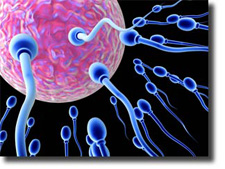Fertile Days To Conceive

Finding The Fertile Days To Conceive
The beginning of a pregnancy is conception, and attempting to plan a conception requires knowing the most fertile days to conceive. The average menstrual cycle for a woman is 28 days, and it is near the mid-point of this cycle or period that the most fertile days to conceive will be found. It's important to know what these days are when planning to become pregnant, or attempting to avoid becoming pregnant.
In general, it is the first week of the menstrual cycle when conception, hence pregnancy, is least likely to occur. To find this period of time, it's necessary to know when the last period began. The last period began on the first day of menstrual bleeding. If that date eludes the memory, then one will have to wait until the beginning of the next menstrual cycle to be able to make an accurate estimate of when the fertile days to conceive will occur.
Once it's known when a period, whether the present one or the next one starts, simply count 14 days from this starting period. This will bring you to the mid-point of the cycle, and the day when an egg is most likely to be produced, a process called ovulation. The first day of a period occurs 12 to 14 days after the last egg was produced, and occurs because the egg failed to become fertilized. Had the egg become fertilized, pregnancy would have begun at that point and there would be no following period.
The Window Of Opportunity - Day 14 then would seem to be the time conception would occur, if it is going to occur. Actually there are a couple of variables involved. First of all, when the egg is produced and enters the uterus, it will remain there for about 12 hours, after which it will begin to disintegrate. The egg then, has a life span of less than a day unless fertilized. From the viewpoint of the egg, the number of fertile days to conceive is something less than one day, and it is nearly impossible to tell exactly what hour of the day the egg will arrive and begin its wait.
The saving grace is that the sperm, when introduced into the vagina, has a significantly longer life span than the egg. Sperm will live up to 48 hours, so can be in the vagina before ovulation actually occurs, and still fertilize the egg. As it may be difficult to pinpoint ovulation to the exact day, this may be good information to know.
28 Days Not Cast In Stone - Given the fact that there is this window of opportunity to conceive, the other variable is one of uncertainty about the length of the menstrual cycle. 28 days is average, but all women aren't average, and for some the length of their period may vary from one month to the next, making it difficult at times to plan ahead. If this is the case, there are still signs to watch for that will tell one when ovulation is most apt to occur or be occurring, hence when the fertile days to conceive are happening.
Basal Temperature - When one is about to ovulate, the basal or body temperature (measured with a basal thermometer) will rise anywhere from half a degree to a degree and a half over a period of several days. This is due to an increase in the production of a hormone, progesterone, which is stimulated by ovulation. Unfortunately, if one waits for the high temperature reading, ovulation has already come and gone, so for this information to be helpful, it's necessary to detect when the temperature begins to rise, which may not be an easy thing to do.
Signs Of Discomfort - Ovulation causes lower abdominal discomfort in many, but not all women. The time which this discomfort is occurring is the most opportune time to get pregnant. This symptom of ovulation only works for around 20% of the female population however. The remainder feels very little discomfort or none at all.
Change In Cervical Mucus - The cervical mucus will change in consistency and texture as the time for ovulation approaches. It does this to protect the sperm in its journey through the uterus and into the fallopian tubes where the egg is waiting. At the time of ovulation, this mucous will often have the consistency of egg white. Like abdominal discomfort and basal temperature, this indicator is not always readily observable for all women, but is generally a good indicator.
So the signs are there, as is a way to count backwards or forwards to find the fertile days to conceive, or not to conceive, if that is the plan.